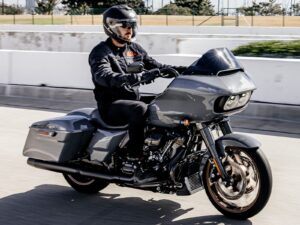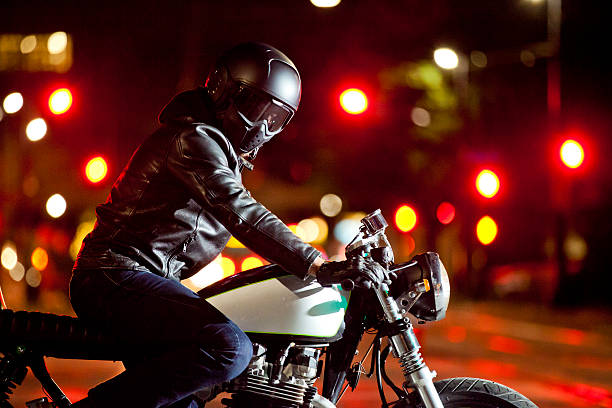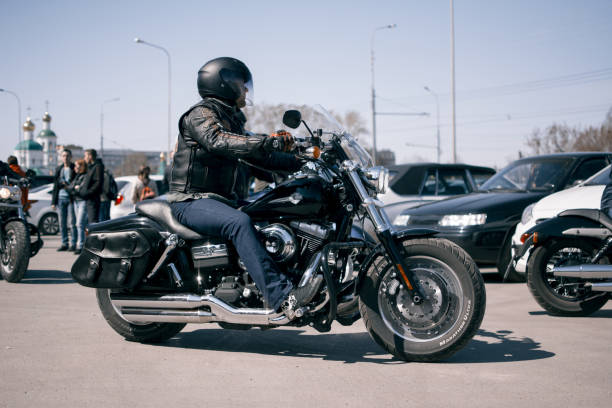The Evolution of Motorcycle Riding Vests: From Utility to Fashion Statement
The motorcycle riding vest has changed dramatically from functional clothing for road protection and convenience to a trendy statement piece that represents personal style and affinities. This voyage reflects evolving motorbike culture and fashion, capturing riders’ ideals, attitudes, and aesthetics across generations.

Motorcycle vests were initially designed to guard against weather and road debris and carry essentials in pockets and bags. These vests, made of leather and, subsequently, synthetic fibers, were functional and rugged, evoking the spirit of early motorcyclists who confronted the wide road with daring and independence.
The vest’s role evolved with motorcycling culture. Motorcycle clubs and associations formed in the mid-20th century, giving riders a sense of community and identification. The vest became a canvas for club logos, patches, and colors to show loyalty and membership. The vest transformed from riding gear to a biker community icon around this time.
Riders customized vests with patches, buttons, and embroidery that expressed their adventures, accomplishments, and philosophies. This customization makes each vest unique, telling the wearer’s stories, values, and road adventures. The motorbike vest had become a work of art that reflected the rider’s personality.
In recent decades, the motorcycle riding vest has transitioned from motorcycle culture to mainstream fashion. Inspired by motorcycle apparel’s rebellious spirit and raw style, designers and fashion companies reimagined vests with modern fabrics, cuts, and designs. Because of this mix of motorcycle culture and high fashion, the vest became more popular and adaptable to different styles and circumstances.
Today, motorcycle riding vests have two meanings. Riders wear it as a badge of honor for their loyalty to the road and community. It gives fashionistas an edge and authenticity, evoking motorbike freedom and rebellion. The vest’s adaptability and popularity are shown by its ability to cross different worlds.
The rebirth of vintage and retro fashions has also boosted the vest’s popularity, with motorcyclists searching out traditional designs and materials that evoke the golden age. Vintage nostalgia and current advancements keep the motorcycle vest relevant and popular among motorcyclists and fashionistas.
The motorcycle riding vest’s transformation from a practical to a fashion statement reflects cultural developments. It shows how clothing can become a statement of identity, community, and style. The vest will change with motorcycle culture, but its adventure, revolt, and unique spirit will inspire future riders and fashionistas.
The motorcycle vest connects motorcycling and fashion in this ever-changing environment. Its evolution shows how cultural symbols can change throughout time. The motorcycle riding vest symbolizes freedom, adventure, and self-expression, whether worn on the road or in the city.
How to Choose the Right Material for Your Motorcycle Vest
The temperature, protection, and style of your motorcycle riding vest all play a role in choosing the suitable material. This gear is more than just a fashion statement it improves riders’ comfort, safety, and self-expression. With so many materials on the market, choosing might be difficult. Understanding each material’s distinct traits and benefits helps riders pick a vest that meets their needs and tastes.

Motorcycle vests have long been made of leather due to its durability and classic charm. Its natural abrasion resistance protects against road rash, making it a safety choice for cyclists. Leather’s wind-blocking and warmth-retaining properties make it excellent for chilly areas. However, its breathability may be an issue in warmer weather, prompting some riders to go elsewhere.
Nylon, polyester, and Kevlar are more versatile and functional than leather. Thanks to these lightweight synthetic textiles, comfort and mobility are appreciated on lengthy rides in hot weather. Many textile vests are waterproof and breathable, improving cycling in many weather conditions. Textiles can also be reinforced with abrasion-resistant panels and reflective components to improve road safety.
Hybrid vests combine leather and textile materials to offer the best of history and innovation. These vests have leather exteriors for protection and aesthetics and textile panels for ventilation and flexibility. This combination provides riders with the classic leather look and the modern benefits of textile technology.
Consider the environmental and ethical impacts of your choice. Sustainable alternatives to leather, such as vegan leather, appeal to ecologically aware riders. These plant-based or synthetic leather-like fabrics are cruelty-free and low-impact.
The material choice affects customization and personal expression. Leather vests let riders show off their club affiliations, achievements, and personal style with patches, embroidery, and paint. Due to their textures and thicknesses, textile vests are harder to tailor, but badges, pins, and other keepsakes can be added.
Motorcycle vest material selection depends on comfort and fit. Fitting well makes a vest look better and positions any new protective features for maximum safety. leather’s custom-fit feel improves with age as it molds to the wearer’s body. Textile materials, on the other hand, have adjustable straps and flexible panels to fit different body types and riding postures.
Maintenance and upkeep are also essential. Fabric vests are machine washable, while leather vests need frequent conditioning to stay soft. This maintenance disparity may influence riders who favor low-effort care.

The material for your motorbike vest depends on personal preference, intended use, and practicality. When choosing a material, riders should consider their protection, climate, maintenance, and style needs. By doing so, customers can choose a motorbike vest that looks good and offers the utility and comfort they need to ride well.
Choosing the correct vest material is crucial in the ever-changing motorcycle gear world. As manufacturers develop new materials and designs, riders will have more alternatives to balance style, comfort, and safety. Whether you pick leather, fabrics, or hybrid materials, your vest should match your riding style and satisfy your road needs.
Knowing the materials and knowing oneself as a rider are both critical when choosing a motorbike vest. It’s a chance to consider what you value most about riding weather protection, freedom of movement, or personal flair. With the correct information and a clear sense of your priorities, finding the right motorbike vest becomes vital in creating your road identity.






Leave a Reply